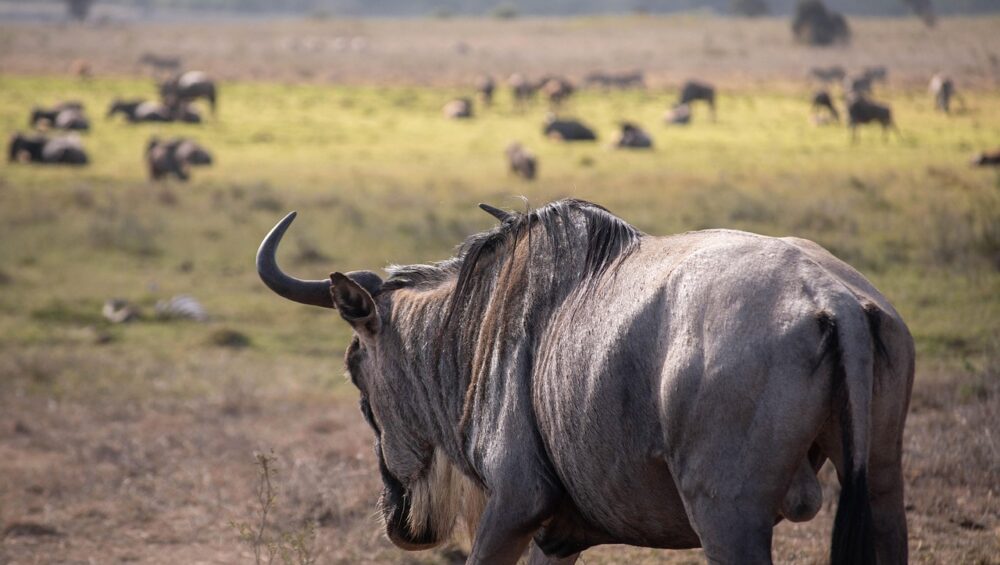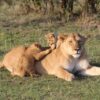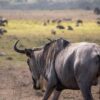The Great Wildebeest Migration is one of the most extraordinary wildlife spectacles on the planet. Each year, over 1.5 million wildebeest, accompanied by hundreds of thousands of zebras and gazelles, embark on a treacherous journey across the vast plains of East Africa in search of fresh grazing land. This epic migration spans the Serengeti National Park in Tanzania and the Maasai Mara National Reserve in Kenya, covering approximately 1,800 miles in a continuous cycle dictated by rainfall and the availability of food.
The migration is not just a movement of animals—it is a dramatic display of survival, as predators like lions, cheetahs, hyenas, and crocodiles lie in wait. The river crossings at the Mara and Grumeti rivers are among the most thrilling moments, as thousands of wildebeest risk their lives against powerful currents and lurking crocodiles.
Why it is Considered One of the Seven Natural Wonders of Africa
The Great Wildebeest Migration has earned its place among the Seven Natural Wonders of Africa due to its sheer scale, ecological significance, and dramatic encounters. Unlike any other wildlife migration on Earth, this journey involves millions of animals moving in a synchronized, cyclical pattern that has been occurring for centuries.
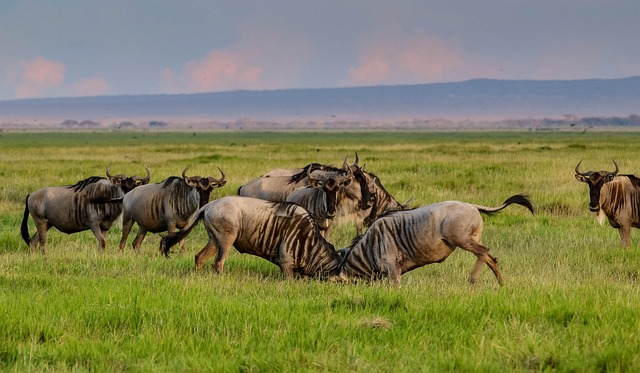
Some key reasons why this event is globally recognized include:
- Unparalleled scale – No other migration involves such a vast number of large mammals traveling together.
- Biodiversity and predator-prey interactions – The migration supports a complex ecosystem, offering extraordinary opportunities to witness predators in action.
- River crossings – The dramatic crossings of the Mara and Grumeti rivers are among nature’s most intense survival challenges.
- Impact on the ecosystem – The migration plays a crucial role in maintaining the grasslands by naturally fertilizing the soil and ensuring the regeneration of plant life.
Because of these unique factors, the migration has been designated as one of Africa’s greatest natural wonders, standing alongside iconic landmarks like Victoria Falls and Mount Kilimanjaro.
Importance of Witnessing This Spectacle for Nature Lovers and Photographers
For nature lovers and wildlife enthusiasts, experiencing the Great Wildebeest Migration is a bucket-list adventure. This event provides an up-close look at the raw beauty of nature, from the synchronized movements of massive herds to the intense predator-prey interactions. Whether it’s witnessing a river crossing or watching newborn calves take their first steps during the calving season, the migration offers unforgettable moments.
For photographers, the migration is a dream come true. The dramatic landscapes of the Serengeti and Maasai Mara, combined with the dynamic action of charging herds and predatory chases, provide endless opportunities for breathtaking wildlife photography. From golden sunrises over the savannah to the heart-stopping leaps of wildebeest into crocodile-infested waters, every moment is a potential masterpiece.
Whether you are a first-time safari-goer or a seasoned wildlife traveler, the Great Wildebeest Migration is a once-in-a-lifetime experience that showcases the true essence of the African wilderness.
Wildebeest Migration Map

A Visual Representation of the Migration Route
The Great Wildebeest Migration follows a circular route that spans across Tanzania’s Serengeti National Park and Kenya’s Maasai Mara National Reserve, covering approximately 1,800 miles annually. The movement is primarily driven by rainfall patterns and the availability of fresh grazing lands. Although often thought of as a single event, the migration is actually a continuous, year-round cycle with different stages occurring in various locations.
A detailed migration map typically highlights four key locations that serve as major landmarks in the migration:
Key Locations in the Migration
- Serengeti National Park (Tanzania)
- The migration begins in the southern Serengeti, particularly in the Ndutu region, where wildebeest give birth to over 500,000 calves between January and March.
- The lush plains provide nutrient-rich grass, ideal for the growth of young calves before the herds move northward.
- This period is also one of the best for predator action, as lions, hyenas, and cheetahs take advantage of vulnerable newborns.
- The migration begins in the southern Serengeti, particularly in the Ndutu region, where wildebeest give birth to over 500,000 calves between January and March.
- Grumeti River (Tanzania)
- Around May to June, as the Serengeti starts to dry up, the herds push westward toward the Grumeti River in the Western Corridor.
- This phase marks the first major water obstacle of the migration. The river is home to large Nile crocodiles, which prey on the crossing wildebeest.
- Those that successfully cross continue moving north toward the Mara River, preparing for the next critical stage.
- Around May to June, as the Serengeti starts to dry up, the herds push westward toward the Grumeti River in the Western Corridor.
- Mara River (Kenya/Tanzania Border)
- Between July and September, the herds face their most dangerous and dramatic challenge—crossing the Mara River to enter Kenya’s Maasai Mara National Reserve.
- The river crossings are the most iconic and photographed part of the migration, featuring thousands of wildebeest leaping into crocodile-infested waters.
- Many do not survive, but those that do make it into the lush grasslands of the Maasai Mara.
- Between July and September, the herds face their most dangerous and dramatic challenge—crossing the Mara River to enter Kenya’s Maasai Mara National Reserve.
- Maasai Mara National Reserve (Kenya)
- From August to October, the herds spread across the Maasai Mara, enjoying the fresh grazing lands.
- This is peak safari season, as predators like lions and leopards take advantage of the influx of prey.
- However, as the short rains begin in Tanzania, the herds start their southward journey back into the Serengeti.
- From August to October, the herds spread across the Maasai Mara, enjoying the fresh grazing lands.
How the Migration is a Continuous Cycle Throughout the Year
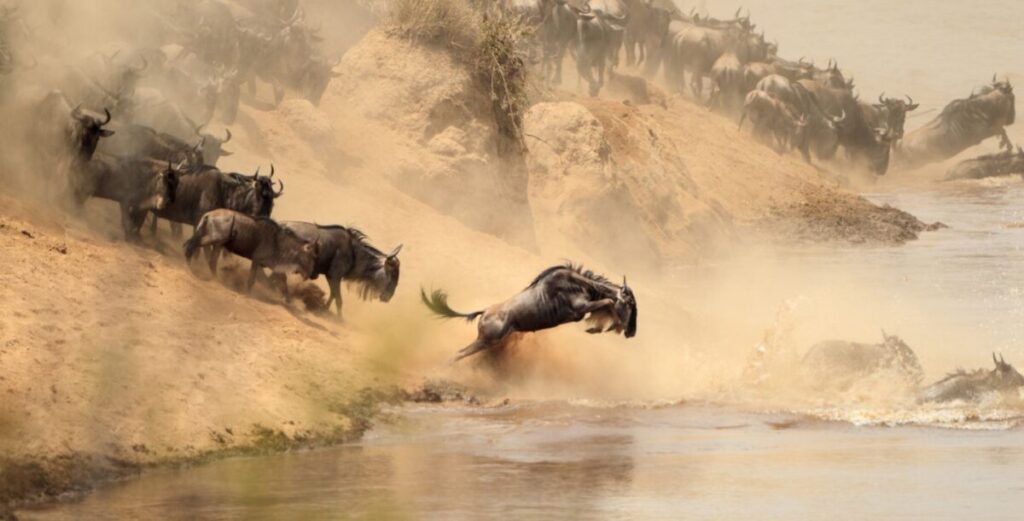
The Great Wildebeest Migration is an endless loop with no true beginning or end. Each stage plays a crucial role in the survival of the herds and the balance of the ecosystem.
Here’s how the cycle continues throughout the year:
- January – March: Calving season in southern Serengeti (Ndutu region). Thousands of calves are born, attracting predators.
- April – May: The herds begin moving northwest toward the Grumeti River, following the rain and fresh grass.
- June – July: The first major obstacle, the Grumeti River crossing, takes place before the herds continue north.
- July – September: The Mara River crossing occurs, the most dramatic part of the migration, as herds enter Kenya’s Maasai Mara.
- October – November: The short rains in Tanzania trigger the return journey southward.
- November – December: The herds move back into the Serengeti, completing the cycle and preparing for another calving season.
This predictable but dangerous journey showcases the resilience of the wildebeest and their instinctive drive to follow nature’s rhythm.
Why Do Wildebeests Migrate?
The Great Wildebeest Migration is one of the most fascinating natural phenomena, driven by instinct, survival, and the search for resources. While the journey may seem chaotic, it follows a well-defined cycle that ensures the herds have access to fresh grazing lands and water throughout the year. The key factors influencing this migration are:
1. Search for Fresh Grazing Lands and Water
Wildebeests are grazing herbivores, relying primarily on nutrient-rich grasses to sustain their large numbers. However, the vast savannas of East Africa experience seasonal changes that directly impact food availability.
- During the wet season (December – May), the southern Serengeti becomes a lush paradise, providing ample grazing opportunities. This is why wildebeests remain in the Ndutu region, where calving takes place.
- As the dry season (June – November) sets in, the grass in the south is depleted, and water sources begin to shrink. This prompts the herds to move northward in search of fresh pastures.
The movement of wildebeests is crucial for maintaining the grassland ecosystem, as their grazing helps prevent overgrowth and promotes new plant life.
2. Response to Seasonal Rainfall Patterns
Unlike many migrations that follow a fixed path each year, the Great Wildebeest Migration is largely dictated by rainfall patterns. Wildebeests have an extraordinary ability to detect rain from over 50 kilometers away, likely sensing changes in air pressure or hearing distant thunder.
- January – March: The herds gather in the Ndutu Plains (Southern Serengeti), where recent rains provide abundant grass and water.
- April – May: As the dry season approaches, the wildebeests begin moving northwest toward the Grumeti River, following the rain.
- June – July: With limited rainfall in the south, the herds push toward the Mara River for water and fresh grass.
- August – October: The Maasai Mara (Kenya) experiences short rains, creating ideal grazing conditions.
- November – December: The return journey to the Serengeti begins as rainfall replenishes the southern plains, completing the cycle.
This natural water-driven movement ensures that the herds never remain in one place for too long, preventing overgrazing and land degradation.
3. The Role of Survival Instincts and the Need to Evade Predators
Migration is not just about food—it’s also about survival. The vast herds of wildebeest are constantly under threat from predators, and their movement helps reduce the risk of over-predation in any single area.
- The calving season (January – March) sees the birth of over 500,000 wildebeest calves in the Ndutu region. However, this attracts lions, hyenas, cheetahs, and leopards, all waiting to prey on the vulnerable newborns.
- By migrating northward, the wildebeests avoid excessive predation in one location and ensure that not all young calves fall prey to predators at once.
- The river crossings at the Grumeti and Mara Rivers present another survival challenge. Nile crocodiles lurk in the waters, waiting for the herds to make the dangerous leap. However, crossing in large numbers increases the chances of individual survival.
- Additionally, the herds remain in open grasslands, making it easier to spot predators like lions and cheetahs before they launch an ambush.
By constantly moving, the wildebeests give themselves the best chance of survival, spreading out risk and ensuring the species thrives year after year.
When Is the Wildebeest Migration?
The Great Wildebeest Migration is a year-round cycle dictated by rainfall patterns and the search for food and water. While many travelers associate it with the dramatic Mara River crossings, the migration includes several important phases, each offering a unique wildlife experience.
Below is a month-by-month breakdown of the migration and its key highlights:
January – March: Calving Season in the Southern Serengeti
Location: Ndutu Plains & Southern Serengeti (Tanzania)
Weather: Warm, with short rains providing lush grazing
Wildlife Highlights:
✔ Over 500,000 wildebeest calves are born within a 2-3 week period.
✔ Predator activity peaks, as lions, hyenas, and cheetahs hunt the vulnerable young.
✔ The best time to witness predator-prey interactions up close.
Why Visit? If you want to see adorable newborn wildebeests and intense predator action, this is the perfect time to go on safari.
April – June: Movement Towards the Central Serengeti & Grumeti River Crossings
Location: Southern & Central Serengeti → Western Corridor
Weather: End of short rains; grass starts drying up
Wildlife Highlights:
✔ Massive herds begin moving north, forming spectacular columns of wildebeests and zebras.
✔ The Grumeti River crossing occurs in May – June, where crocodiles lie in wait.
✔ The rutting (mating) season begins, with dramatic male fights for dominance.
Why Visit? If you want to witness the first major river crossing and impressive herd movements, this is a great time for photography and safari experiences.
July – September: Dramatic Mara River Crossings into Kenya
Location: Northern Serengeti (Tanzania) → Maasai Mara (Kenya)
Weather: Dry season; cooler temperatures
Wildlife Highlights:
✔ The most famous part of the migration, where wildebeests cross the Mara River in their thousands.
✔ Spectacular crocodile attacks and chaotic scenes as animals leap into the water.
✔ The Maasai Mara becomes a prime location for big cat sightings (lions, leopards, cheetahs).
Why Visit? If you want to see the world’s most dramatic river crossings, this is the best time to travel to Kenya’s Maasai Mara.
October – November: Wildebeests Return to the Serengeti
Location: Maasai Mara (Kenya) → Northern Serengeti & Eastern Serengeti (Tanzania)
Weather: Short rains begin, bringing fresh grass to the Serengeti
Wildlife Highlights:
✔ Herds start moving south, crossing the Mara River again—but with less intensity.
✔ The plains begin to turn green, attracting thousands of grazing animals.
✔ Predators continue to follow the herds, leading to exciting wildlife encounters.
Why Visit? If you prefer fewer crowds and still want to see the migration, this is a great time for a more relaxed safari experience.
December: The Cycle Starts Again
Location: Eastern & Southern Serengeti (Tanzania)
Weather: Rainfall increases, creating lush grazing lands
Wildlife Highlights:
✔ The herds settle in Ndutu and Southern Serengeti, preparing for the next calving season.
✔ More elephants, giraffes, and antelopes are visible as the ecosystem flourishes.
✔ Predators prepare for the next wave of young wildebeests, making for exciting game drives.
Why Visit? If you want to witness the beginning of the migration cycle, this is an excellent time to see diverse wildlife and lush landscapes.
Best Time to Visit for the Migration
🔹 Best for Calving & Predator Action: January – March (Southern Serengeti)
🔹 Best for River Crossings: July – September (Mara River)
🔹 Best for Fewer Crowds & Lush Landscapes: October – December
Since the migration is continuous, there is no “wrong” time to witness it—each season offers something unique!
When to Avoid Maasai Mara
While the Maasai Mara is one of Africa’s best wildlife destinations, certain times of the year may not be ideal for visiting—especially if your goal is to witness the Great Wildebeest Migration. Here’s what to consider:
1. Months When the Migration is Not in the Maasai Mara (November – June)
The Great Wildebeest Migration follows a circular pattern, and the wildebeest herds typically leave the Maasai Mara by late October as they begin their journey back to the Serengeti in Tanzania.
- November – December: The herds move southward across the Serengeti after the short rains begin.
- January – March: Calving season happens in Ndutu and Southern Serengeti, making it the best time to visit Tanzania instead.
- April – June: The herds gradually move toward the Grumeti River, still far from the Maasai Mara.
Why Avoid the Maasai Mara During These Months?
If your goal is to see large herds of migrating wildebeests, the Maasai Mara is not the best place from November to June. Instead, a Tanzania safari in the Serengeti would offer better migration experiences.
2. The Impact of Heavy Rains on Accessibility and Game Viewing
Kenya’s rainy seasons—March to May (long rains) and November (short rains)—can significantly affect safari conditions in the Maasai Mara.
- Road Conditions: The Maasai Mara’s roads can become muddy and difficult to navigate, especially in April and May. Some camps may even close temporarily.
- Wildlife Visibility: During the rains, animals disperse because water is available everywhere, making wildlife harder to track.
- Photography Challenges: Overcast skies and heavy rainfall may not provide the best conditions for photography enthusiasts.
Best Alternative? If visiting during the rainy season, consider lodges in private conservancies near the Maasai Mara, where fewer crowds and better-managed roads improve the experience.
3. Crowd Levels and Peak Season Pricing
The Maasai Mara is one of Africa’s most visited safari parks, and peak season (July – October) sees a huge influx of tourists.
- Peak Season (July – October):
✔ Best time for migration, but large crowds can diminish the “wild” experience.
✔ Safari lodges and camps increase prices, making it one of the most expensive times to visit. - Low Season (March – May):
✔ Prices are significantly lower, but heavy rains affect game drives.
✔ Fewer tourists, making for a more private safari experience.
When to Visit for Fewer Crowds & Good Game Viewing?
- June: Just before peak season, with fewer tourists and good wildlife viewing.
- November: After the migration leaves, but before heavy rains disrupt the terrain.
Would you like recommendations on alternative parks in Kenya for the off-season?
Masai Mara or Serengeti in October: Which is Better?
October is a transitional month in the Great Wildebeest Migration, as herds start leaving the Maasai Mara and head back into the Serengeti. Deciding between the two depends on several factors:
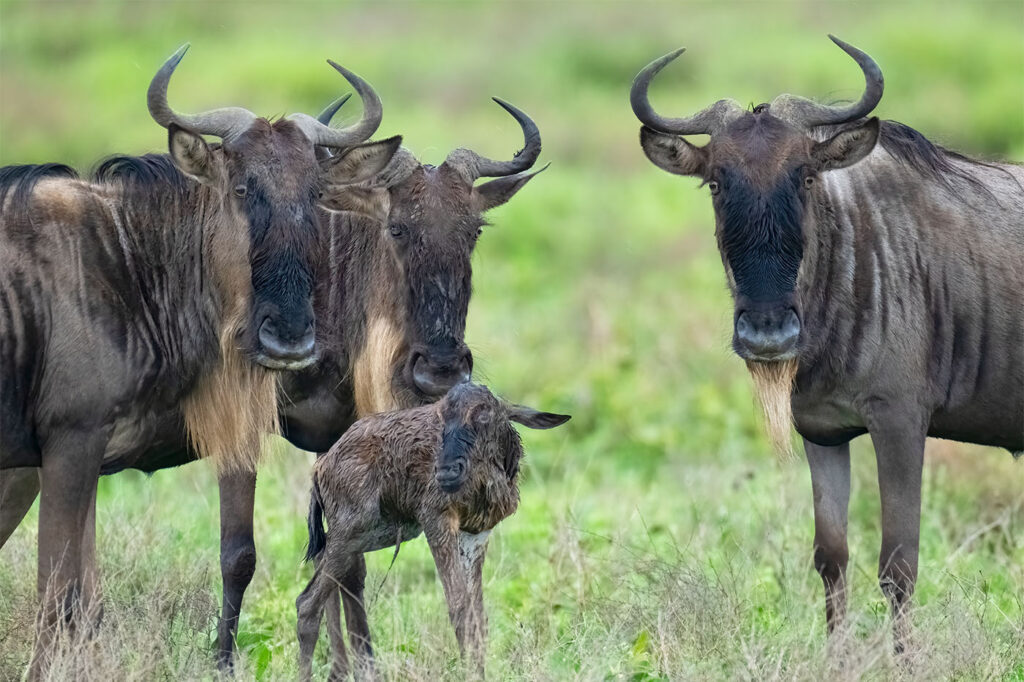
1. Number of Wildebeests Present
- In early October, the Maasai Mara still has large herds, but numbers begin decreasing toward the month’s end.
- The Northern Serengeti starts receiving the migrating herds as they cross back into Tanzania.
- By mid-to-late October, the best migration sightings shift to the Serengeti.
Best Choice:
✔ Early October → Maasai Mara still has good migration action.
✔ Late October → Northern Serengeti is the better choice.
2. Weather Conditions
- October marks the transition from dry season to short rains in both parks.
- Maasai Mara: Still dry, but occasional rain showers begin.
- Serengeti: Light rains in northern Serengeti, but still great for wildlife viewing.
Best Choice: If you want better photography conditions and clear skies, the Maasai Mara in early October is slightly better.
3. Crowd Levels
- Maasai Mara: Since it’s the tail end of migration season, crowds begin to thin, making it less congested than peak months.
- Serengeti: The Northern Serengeti is quieter, with fewer tourists compared to the Maasai Mara.
Best Choice: If you prefer fewer crowds, the Serengeti is better in October, especially in the Lobo or Kogatende regions.
Best Lodges & Camps for the Great Wildebeest Migration in October
Your choice of accommodation depends on where you want to experience the migration—either the Maasai Mara (early October) or Northern Serengeti (mid to late October). Here are the best lodges and camps in each region:
Maasai Mara (Kenya) – Best for Early October
If visiting in early October, the Maasai Mara is still a great choice as some herds remain before crossing back into Tanzania. Here are some top picks:
1. &Beyond Kichwa Tembo Tented Camp
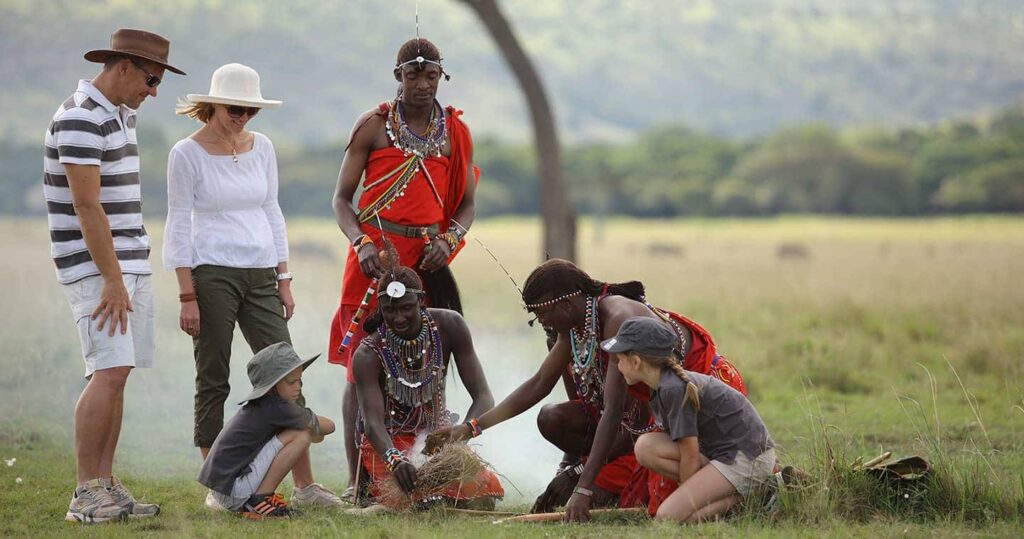
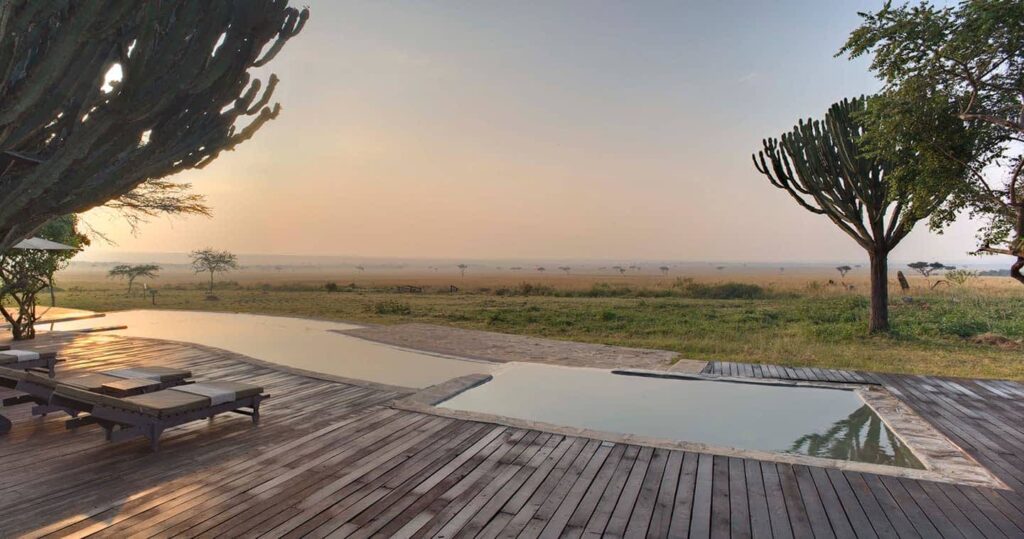
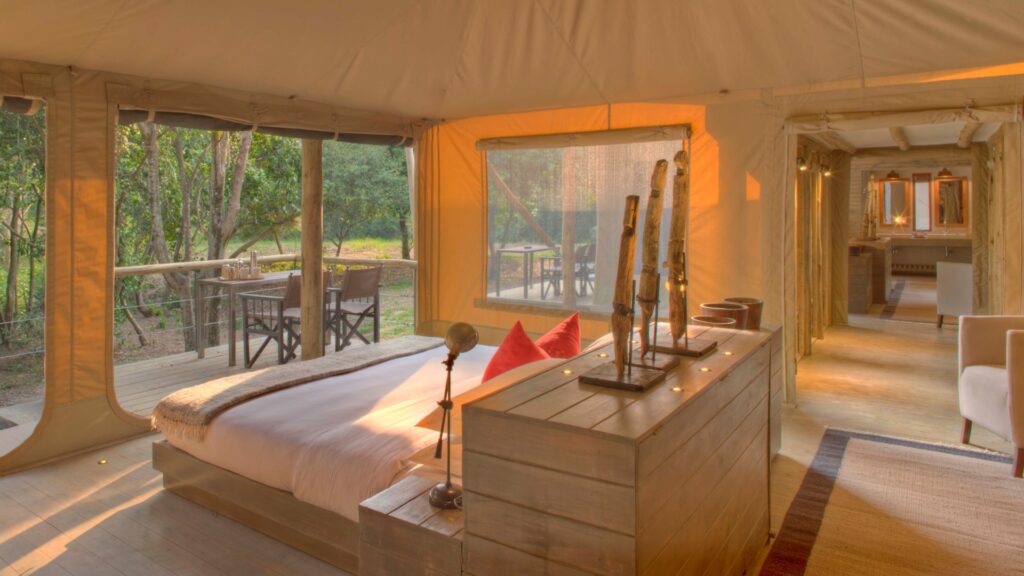
- Location: Private concession near the Mara River
- Why Choose It?
✔ Stunning views of the plains and Mara River crossings
✔ Luxurious yet eco-friendly tents
✔ Fewer crowds compared to main Mara lodges
2. Mara Serena Safari Lodge


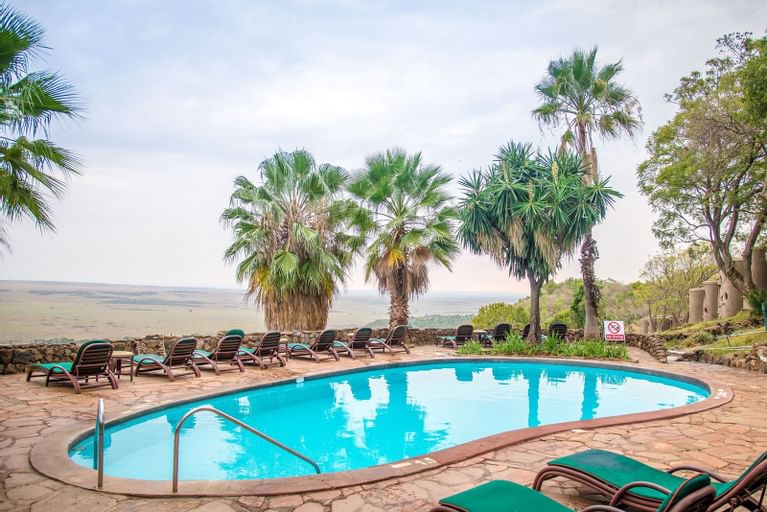
- Location: On a hill overlooking the Mara River
- Why Choose It?
✔ Prime spot for wildebeest crossings
✔ Mid-range but offers spectacular views
✔ Has a swimming pool with a panoramic view of the Mara plains
3. Governors’ Camp


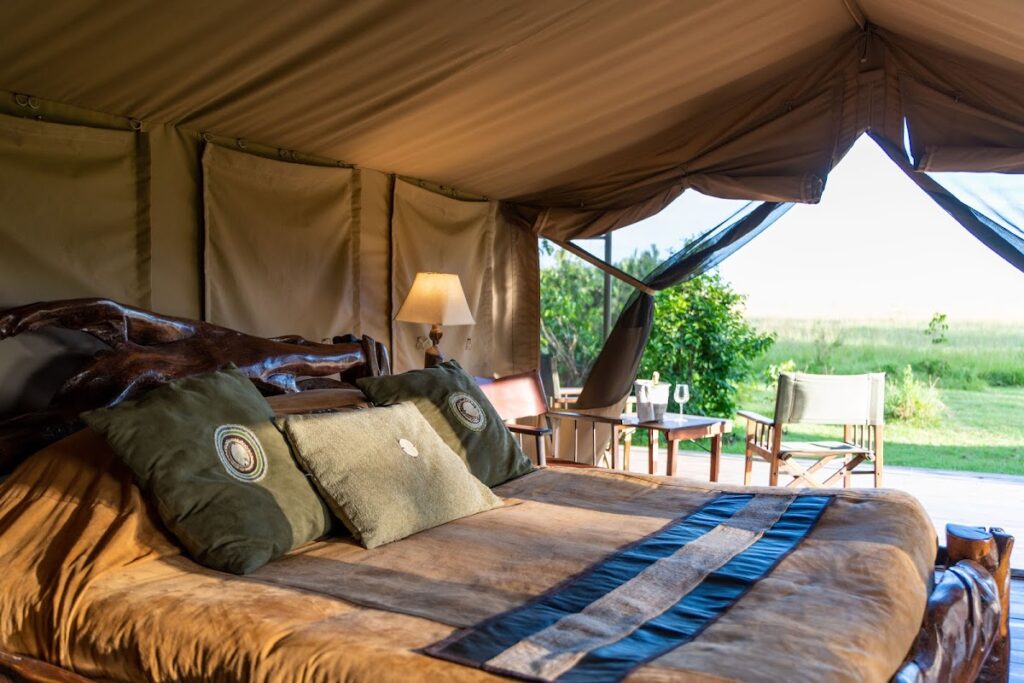
- Location: Along the Mara River
- Why Choose It?
✔ Rich in history—one of the oldest luxury camps
✔ Frequent big cat sightings nearby
✔ Located in the heart of the migration route
4. Rekero Camp
- Location: Close to the Talek River, great for early crossings
- Why Choose It?
✔ Small, intimate safari experience
✔ Excellent for wildlife photography
✔ Personal butler service and top-notch guiding
Northern Serengeti (Tanzania) – Best for Mid to Late October
If visiting in mid to late October, the herds have begun crossing back to Tanzania, making the Northern Serengeti a better option.
1. Sayari Camp (Asilia Africa)
- Location: Kogatende, near the Mara River
- Why Choose It?
✔ One of the best lodges for late migration crossings
✔ Exclusive and luxurious—perfect for honeymooners
✔ Great for walking safaris and hot air ballooning
2. Serengeti Bushtops Camp
- Location: Near the Mara River, Northern Serengeti
- Why Choose It?
✔ Luxury tents with private hot tubs
✔ Offers night game drives (rare in Serengeti)
✔ Exceptional food & service
3. Lemala Kuria Hills Lodge
- Location: Wogakuria Hills, near Mara River crossings
- Why Choose It?
✔ Elegant suites with glass walls for panoramic views
✔ Great for late-season migration sightings
✔ Secluded & romantic atmosphere
4. Mara River Tented Camp (Singita)
- Location: Prime migration area in Kogatende
- Why Choose It?
✔ Ultra-luxury experience in a remote setting
✔ Offers private game drives with expert guides
✔ Ideal for those who want an exclusive safari experience
Budget-Friendly Alternatives
If you prefer a more affordable safari experience, consider:
Kenya (Maasai Mara)
✔ Mara Eden Safari Camp – Mid-range tented camp along the Mara River
✔ Osero Camp – A small eco-friendly camp with fewer crowds
Tanzania (Northern Serengeti)
✔ Chaka Camp – Mobile tented camp following the migration
✔ Mbugani Migration Camp – Great budget-friendly option near Kogatende
How Wildebeests Handle Predators
The Great Wildebeest Migration is one of the most dangerous journeys in the animal kingdom. Along the way, wildebeests must constantly evade predators that see them as a vital source of food. Despite the high risks, these animals have developed remarkable survival strategies to increase their chances of making it through the migration.
Survival Strategies
1. Safety in Numbers – The Power of a Large Herd
Wildebeests travel in herds of thousands, which provides safety through numbers. This is one of their most effective survival tactics, as predators struggle to target a single individual in a moving mass.
- Confusion Effect: A stampeding herd makes it harder for predators to focus on one wildebeest.
- More Eyes on the Lookout: With thousands of wildebeests together, many individuals can spot danger early.
- Protection for the Young: Calves stick close to their mothers and are shielded within the larger herd.
Fun Fact: Even though thousands of wildebeests are taken by predators each year, their population remains stable because of their high birth rate—over 500,000 calves are born during calving season in the Southern Serengeti!
2. Speed and Alertness – How They React to Danger
Wildebeests are not easy prey—they are fast and highly alert to threats.
- Top Speed: Wildebeests can run at speeds of up to 80 km/h (50 mph), allowing them to outrun lions and hyenas in short bursts.
- Quick Reaction Time: They respond instantly to sudden movements or the alarm calls of other animals.
- Sharp Instincts: Even newborn calves stand and run within minutes of birth, giving them a better survival chance.
Fun Fact: When chased, wildebeests don’t run in a straight line—they zigzag and change direction suddenly to confuse their attackers!
3. Relying on Zebras and Gazelles for Early Warning
Wildebeests are often seen traveling with zebras and Thomson’s gazelles, forming a mutual protection alliance.
- Zebras Have Better Eyesight: Zebras can spot predators from a distance, giving wildebeests more time to react.
- Gazelles Have Sharp Hearing: Gazelles are smaller but extremely alert, detecting predators before they attack.
- Different Grazing Patterns: Zebras eat taller grass, while wildebeests prefer shorter grass, allowing them to coexist without competing for food.
Fun Fact: Zebras and wildebeests often sleep in shifts—while zebras remain alert during the day, wildebeests stay awake longer at night, reducing the chances of a surprise attack.
Common Predators During the Migration
1. Lions – Targeting Weak and Isolated Individuals
Lions are the top predators of the migration and can be seen waiting in ambush along the migration route.
- Preferred Targets: Weak, injured, or isolated wildebeests.
- Hunting Tactics: Lions hunt in coordinated groups, surrounding a herd and cutting off stragglers.
- Most Dangerous Areas: Lions are most active in calving areas (Ndutu, Serengeti) and river crossing zones where wildebeests are vulnerable.
2. Crocodiles – Ambushing During River Crossings
One of the most dangerous moments for migrating wildebeests is when they must cross rivers like the Grumeti and Mara Rivers. These waters are home to some of Africa’s largest crocodiles, which lie in wait for the perfect opportunity to strike.
- Hunting Tactics: Crocodiles remain still underwater, launching an explosive ambush when a wildebeest gets too close.
- Preferred Targets: Wildebeests that hesitate or get stuck in deep water.
- Most Dangerous Locations: The Mara River (Kenya) and Grumeti River (Tanzania).
3. Cheetahs & Leopards – Targeting Young Wildebeests
Unlike lions and crocodiles, cheetahs and leopards prefer smaller, weaker prey.
Cheetahs (The Fastest Predator)
- Hunting Style: Cheetahs rely on speed, chasing young or isolated wildebeests over short distances.
- Preferred Targets: Wildebeest calves (especially during the calving season).
- Most Dangerous Locations: Open grasslands of the Southern and Central Serengeti.
Leopards (The Stealthy Hunter)
- Hunting Style: Leopards ambush wildebeests at night, using trees or rocky areas for cover.
- Preferred Targets: Smaller wildebeests that stray from the herd.
- Most Dangerous Locations: Wooded areas along riverbanks in the Serengeti and Maasai Mara.
How to Book the Best Migration Safari with RealEdge Tours
At RealEdge Tours, we specialize in creating custom-tailored migration safaris to ensure you experience the best of this world-famous event. We offer:
✅ Expertly crafted itineraries for the Serengeti and Masai Mara
✅ Handpicked luxury lodges and tented camps in prime migration areas
✅ Knowledgeable local guides with deep wildlife expertise
✅ Flexible private safaris and group options
✅ Exclusive game drives to capture the best migration moments
Book Early for the Best Safari Deals
The Great Migration is one of Africa’s most in-demand safari experiences, and accommodations in prime locations sell out months in advance. To secure the best lodges, camps, and guides, we recommend:
🔹 Booking at least 6–12 months in advance for peak season (July–September)
🔹 Taking advantage of early-bird discounts on safari packages
🔹 Considering shoulder season safaris (May–June, October) for fewer crowds and better rates
Ready to Plan Your Dream Safari?
Contact RealEdge Tours today to start planning your perfect migration safari. Whether you’re looking for luxury lodges, mobile camps, or adventure safaris, we’ll help you design an experience that fits your budget and preferences.

